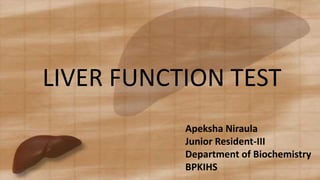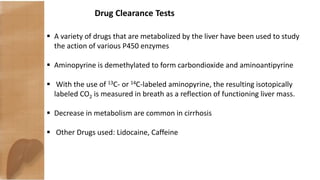This document provides information on liver function tests. It begins with an overview of liver anatomy and functions including synthesis, metabolism, and excretion. It then discusses specific tests that evaluate these hepatic functions and their clinical implications. Details are provided on liver zonation and regeneration. Key proteins and enzymes synthesized by the liver are outlined. Metabolic functions like ammonia, carbohydrate, and xenobiotic metabolism are reviewed. Inherited disorders of bilirubin metabolism that can cause jaundice are also summarized.


![ Liver Function Test [Misnomer]- describes the measurement of
distinct physiological and biochemical organ functions that have
meaning in the absence of any organ pathology
Enzymes like Aminotransferases have major and well defined roles
within the cell, but have no functional significance at all in plasma
They are simply the markers of hepatocyte disruption](https://image.slidesharecdn.com/liverfunctiontest-200130090753/85/Liver-function-test-3-320.jpg)










![Metabolic Function
Ammonia Metabolism
The major source of circulating ammonia is the GI tract
Aromatic Amino Acids [AAA] are metabolized in the liver while branched chain
amino acid [BCAA] are taken up largely by muscle
Ratio of BCAA/AAA is decreased in Acute Liver Failure and this alteration forms
the basis of one theory of Hepatic Encephalopathy
Ammonia enters tissue of the central nervous system by Passive diffusion
The rate of entry increases in proportion to the plasma concentration and is
dependent on pH](https://image.slidesharecdn.com/liverfunctiontest-200130090753/85/Liver-function-test-14-320.jpg)







![Heme
(250 to 400 mg/day)
Heme oxygenase
Biliverdin reductase
Hemoglobin
(70 to 80%) Erythroid cells
Heme proteins
myoglobin, cytochromes
(20 to 25%)
Biliverdin
Bilirubin
NADPH + H+
NADP+
3 [O]
Fe3+ + CO
apoferritinferritin
Indirect
Unconjugated Bilirubin
Albumin
Bilirubin Production](https://image.slidesharecdn.com/liverfunctiontest-200130090753/85/Liver-function-test-22-320.jpg)


![Clinical Significance
Jaundice: Characterised by Hyperbilirubinemia and deposition of bile pigment in
the skin, mucous membranes and sclera with a resulting yellow appearance of
the patient [ICTERUS]
Defects in bilirubin metabolism resulting in Jaundice can occur at each step of
the metabolic pathway
Inherited Disorders of Bilirubin Metabolism
Jaundice of Newborn](https://image.slidesharecdn.com/liverfunctiontest-200130090753/85/Liver-function-test-25-320.jpg)











![Dye Excretion Tests
Dye excretion tests [such as bromsulphthalein (BSP) and Indocyanine
green (ICG) clearance] were formerly used as Indicators of liver disease
With the development of more sensitive and specific indicators of liver
disease, dye excretion tests have become obsolete](https://image.slidesharecdn.com/liverfunctiontest-200130090753/85/Liver-function-test-37-320.jpg)











![Hepatic Storage Function
Storage of Energy-rich carbohydrate substrates; Glycogen
Hepatic storage of Glycogen allows the release of glucose to other tissue when
the need exists [ When plasma concentration of glucose decrease]
Iron storage, Vitamin A,D,E and B12 storage.](https://image.slidesharecdn.com/liverfunctiontest-200130090753/85/Liver-function-test-49-320.jpg)









